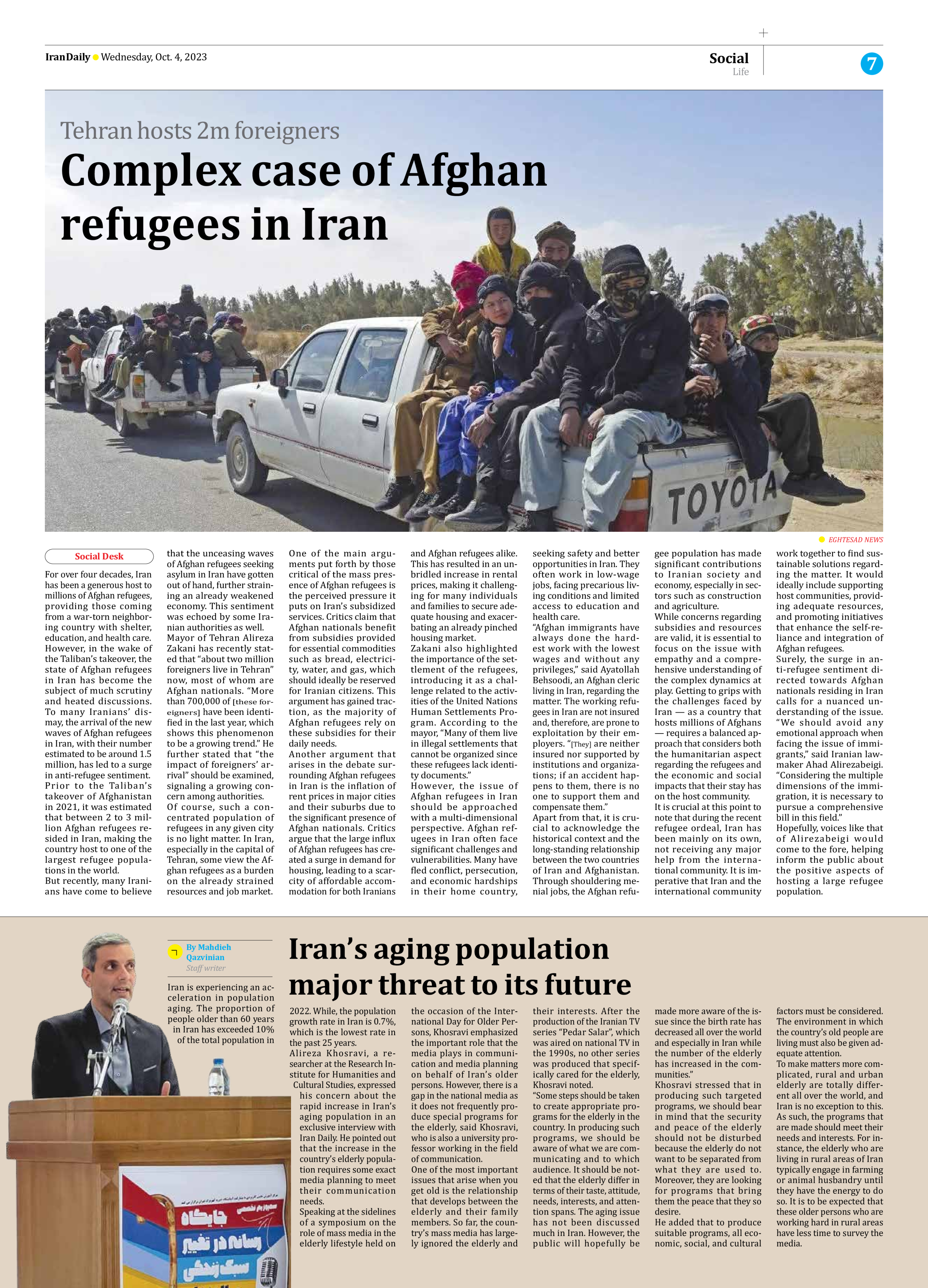
Tehran hosts 2m foreigners
Complex case of Afghan refugees in Iran
For over four decades, Iran has been a generous host to millions of Afghan refugees, providing those coming from a war-torn neighboring country with shelter, education, and health care.
However, in the wake of the Taliban’s takeover, the state of Afghan refugees in Iran has become the subject of much scrutiny and heated discussions. To many Iranians’ dismay, the arrival of the new waves of Afghan refugees in Iran, with their number estimated to be around 1.5 million, has led to a surge in anti-refugee sentiment.
Prior to the Taliban’s takeover of Afghanistan in 2021, it was estimated that between 2 to 3 million Afghan refugees resided in Iran, making the country host to one of the largest refugee populations in the world.
But recently, many Iranians have come to believe that the unceasing waves of Afghan refugees seeking asylum in Iran have gotten out of hand, further straining an already weakened economy. This sentiment was echoed by some Iranian authorities as well.
Mayor of Tehran Alireza Zakani has recently stated that “about two million foreigners live in Tehran” now, most of whom are Afghan nationals. “More than 700,000 of [these foreigners] have been identified in the last year, which shows this phenomenon to be a growing trend.” He further stated that “the impact of foreigners’ arrival” should be examined, signaling a growing concern among authorities.
Of course, such a concentrated population of refugees in any given city is no light matter. In Iran, especially in the capital of Tehran, some view the Afghan refugees as a burden on the already strained resources and job market.
One of the main arguments put forth by those critical of the mass presence of Afghan refugees is the perceived pressure it puts on Iran’s subsidized services. Critics claim that Afghan nationals benefit from subsidies provided for essential commodities such as bread, electricity, water, and gas, which should ideally be reserved for Iranian citizens. This argument has gained traction, as the majority of Afghan refugees rely on these subsidies for their daily needs.
Another argument that arises in the debate surrounding Afghan refugees in Iran is the inflation of rent prices in major cities and their suburbs due to the significant presence of Afghan nationals. Critics argue that the large influx of Afghan refugees has created a surge in demand for housing, leading to a scarcity of affordable accommodation for both Iranians and Afghan refugees alike. This has resulted in an unbridled increase in rental prices, making it challenging for many individuals and families to secure adequate housing and exacerbating an already pinched housing market.
Zakani also highlighted the importance of the settlement of the refugees, introducing it as a challenge related to the activities of the United Nations Human Settlements Program. According to the mayor, “Many of them live in illegal settlements that cannot be organized since these refugees lack identity documents.”
However, the issue of Afghan refugees in Iran should be approached with a multi-dimensional perspective. Afghan refugees in Iran often face significant challenges and vulnerabilities. Many have fled conflict, persecution, and economic hardships in their home country, seeking safety and better opportunities in Iran. They often work in low-wage jobs, facing precarious living conditions and limited access to education and health care.
“Afghan immigrants have always done the hardest work with the lowest wages and without any privileges,” said Ayatollah Behsoodi, an Afghan cleric living in Iran, regarding the matter. The working refugees in Iran are not insured and, therefore, are prone to exploitation by their employers. “[They] are neither insured nor supported by institutions and organizations; if an accident happens to them, there is no one to support them and compensate them.”
Apart from that, it is crucial to acknowledge the historical context and the long-standing relationship between the two countries of Iran and Afghanistan. Through shouldering menial jobs, the Afghan refugee population has made significant contributions to Iranian society and economy, especially in sectors such as construction and agriculture.
While concerns regarding subsidies and resources are valid, it is essential to focus on the issue with empathy and a comprehensive understanding of the complex dynamics at play. Getting to grips with the challenges faced by Iran — as a country that hosts millions of Afghans — requires a balanced approach that considers both the humanitarian aspect regarding the refugees and the economic and social impacts that their stay has on the host community.
It is crucial at this point to note that during the recent refugee ordeal, Iran has been mainly on its own, not receiving any major help from the international community. It is imperative that Iran and the international community work together to find sustainable solutions regarding the matter. It would ideally include supporting host communities, providing adequate resources, and promoting initiatives that enhance the self-reliance and integration of Afghan refugees.
Surely, the surge in anti-refugee sentiment directed towards Afghan nationals residing in Iran calls for a nuanced understanding of the issue. “We should avoid any emotional approach when facing the issue of immigrants,” said Iranian lawmaker Ahad Alirezabeigi. “Considering the multiple dimensions of the immigration, it is necessary to pursue a comprehensive bill in this field.”
Hopefully, voices like that of Alirezabeigi would come to the fore, helping inform the public about the positive aspects of hosting a large refugee population.







